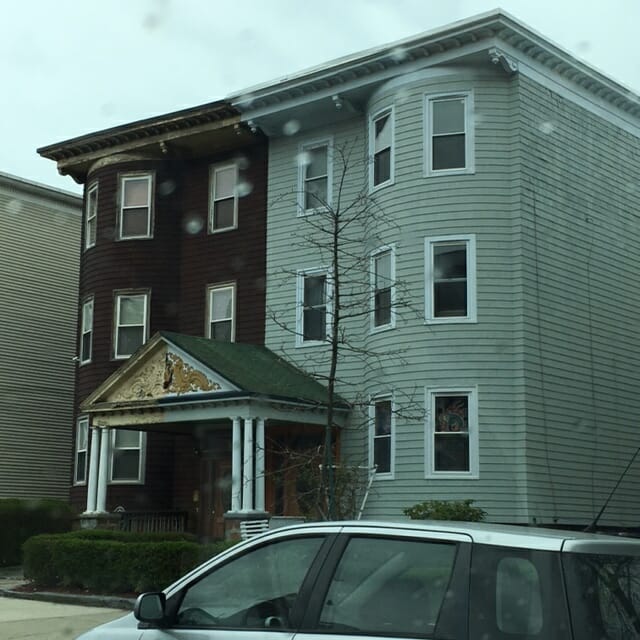Overhoused Seniors

The term “overhoused senior” is being bandied about again. The statistics are clear. Seniors in single-family housing tend to stay in that housing after their children reach adulthood and move out. This intensifies the local housing shortage. More seniors live in three (or more) bedroom housing than in previous generations.
Today, I write from the intersection of retired person and retired real estate broker. I think that part of our local inefficiency is a result of housing use being changed to allow conversion of two-family housing to condos (in buildings created for two-family housing).
Multifamily housing is efficient!
Buying with family to create a multi-generational household currently works for about fifteen percent of buyers. In towns like Somerville, Cambridge, Brookline, and Arlington, this kind of flexible housing thrived before the days of condos. [source]
The housing trend in Massachusetts changed since the 1970s. Massachusetts currently allows owners to convert a two- or three-family house deed into separate condominium deeds.
The demand for housing in eastern Massachusetts caused the sale price of the combined two or three condos to be greater than the sale price for the entire two or three-family house. Therefore, financial incentives lean toward condos replacing two and three-family use of these buildings.
Quick example:
A common Somerville two-family house has about 6 bedrooms. The layouts vary, but 5-8 bedrooms is typical. The average sale price for a two-family house in Somerville was just over $1M in the past 12 months.
A three-bedroom renovated condo sells for about $1M in Somerville. Renovating and selling two units is far more lucrative than keeping it as a two-family house.
Throughout my career, people who wanted to purchase two- and three-family housing struggled because the price of these buildings was driven up by the profit available to those who renovated and converted to condos. This, in my opinion as a retired real estate broker, is a large contributor to housing price inflation.
How does an efficiently used two-family house work?
What used to be typical in Somerville, Cambridge, Boston, Brookline, and many cities in eastern Massachusetts were family compounds in two- and three-family houses.
A young couple would purchase the house and live in the small unit. They could rent the other unit to offset their housing costs. If they outgrew it because they had children or needed a home office, they could move upstairs to the bigger unit. After child-raising years, sometimes their young adult children would live in the smaller unit and the parents stay in the “family home” part of the house. Sometimes, the older generation would move to the smaller unit and the young adults take the bigger upstairs unit, with or without children of their own.
In these spaces, there is a possibility of a closed door, and full privacy, but also the option to open the doors and have children moving freely between the two households.
Why is this more efficient?
By owning separate apartments, an extended family can use the different-sized units in an efficient way. Smaller family groups (such as older adults) can live in smaller units and open larger units for people who need them because of larger family size. Switching so-called “overhoused seniors” from the four-bedroom upstairs unit to the two-bedroom first floor unit is relatively inexpensive. That frees up a larger living space for a bigger family unit (whether it is family or a renter).
The loss of two-family housing stock because these properties are now condos has contributed to the local shortage of three- or more bedroom housing.
How it used to work in Somerville
I rented in a two-family that functioned that way.
It was purchased around 1920 by a couple who had two daughters. The couple raised the two children in the upstairs unit. Both parents lived in that unit until they died. The first-floor unit had five rooms and two bedrooms; the second floor had an additional small room off the living room, which could be a tiny bedroom or study.
One of the daughters moved into the downstairs unit when she got married. She raised three children in that apartment, with her parents upstairs. She was 80 when she moved to a condo in 1996. I lived with my husband in her parents’ unit for the last six years that this extended family owned that house.
In 1996, the house was sold to the family next door. The neighbors rented it for a while, then deeded it to their daughter and her husband. So now, the house I lived in is in a family compound again: just a bigger one, with side-by-side two family houses.
The current and previous purchasers of the last house I rented were immigrants.
That was the old-fashioned way to use a two-family house. The return to this trend peaked in 2020. However, it peaked unevenly. White homeowners are less likely to buy a two or three-family house to create a multi-generational household. While only ten percent of Caucasian buyers purchased multi-generational homes from July 2021 to June 2022, the amount was much higher at eighteen to nineteen percent for Black, AAPI, Hispanic and Latino buyers. [source]